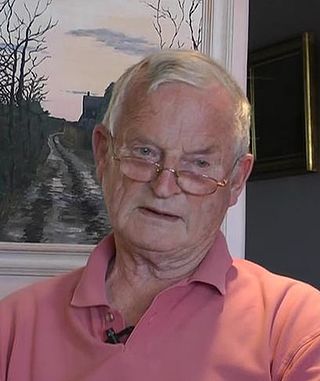Commodore is a senior naval rank used in many navies which is equivalent to brigadier or brigadier general and air commodore. It is superior to a navy captain, but below a rear admiral. It is either regarded as the most junior of the flag officers rank or may not hold the jurisdiction of a flag officer at all depending on the officer's appointment. Non-English-speaking nations commonly use the rank of flotilla admiral, counter admiral, or senior captain as an equivalent, although counter admiral may also correspond to rear admiral lower half abbreviated as RDML.

Admiral Sir John Forster "Sandy" Woodward, was a senior Royal Navy officer who commanded the Task Force of the Falklands War.

The Home Fleet was a fleet of the Royal Navy that operated from the United Kingdom's territorial waters from 1902 with intervals until 1967. In 1967, it was merged with the Mediterranean Fleet creating the new Western Fleet.

Admiral Sir Martin Eric Dunbar-Nasmith, was a Royal Navy officer and a recipient of the Victoria Cross, the highest award for gallantry in the face of the enemy that can be awarded to British and Commonwealth forces. He was born Martin Eric Nasmith, adding "Dunbar" to his surname in 1923.

Admiral Sir Max Kennedy Horton, was a British submariner during the First World War and commander-in-chief of the Western Approaches in the later half of the Second World War, responsible for British participation in the Battle of the Atlantic.

The Commander-in-Chief Fleet (CINCFLEET) was the admiral responsible for the operations of the ships, submarines and aircraft of the British Royal Navy from 1971 until April 2012. The post was subordinate to the First Sea Lord, the professional head of the Naval Service. In its last years, as the Navy shrank, more administrative responsibilities were added.

The Commander-in-Chief, The Nore, was an operational commander of the Royal Navy. His subordinate units, establishments, and staff were sometimes informally known as the Nore Station or Nore Command. The Nore is a sandbank at the mouth of the Thames Estuary and River Medway. In due course the Commander-in-Chief became responsible for sub-commands at Chatham, London, Sheerness, Harwich and the Humber.
Commodore was an early title and later a rank in the United States Navy, United States Coast Guard and the Confederate States Navy, and also has been a rank in the United States Public Health Service Commissioned Corps and the National Oceanic and Atmospheric Administration Commissioned Officer Corps and its ancestor organizations. For over two centuries, the designation has been given varying levels of authority and formality.

The Royal Navy Submarine Service is one of the five fighting arms of the Royal Navy. It is sometimes known as the Silent Service, as submarines are generally required to operate undetected.

The Navy Command is the current headquarters body of the Royal Navy, and as of 2012 its major organisational grouping. It is a hybrid, neither a command, nor simply an installation. Royal Navy official writings describe Navy Command Headquarters both as a physical site, on Whale Island, Hampshire, a collective formed of the most senior RN officers, and as a budgetary grouping.
Vice Admiral Sir John Anthony Rose Troup, was a Royal Navy officer. A submariner, he served as the last Commander-in-Chief Far East Fleet (1971).

The Flag Officer Scotland and Northern Ireland (FOSNI) was a senior post in the Royal Navy of the United Kingdom. It was based at HM Naval Base Clyde, and the holder of the post was the Royal Navy’s senior officer in Scotland. The post of FOSNI, dating from 1946, was re-scoped and re-named in 1994 to Flag Officer Scotland, Northern England & Northern Ireland (FOSNNI), then named back in 2015, before being dis-established in 2020.

The Assistant Chief of the Naval Staff (A.C.N.S.) is a senior appointment in the Royal Navy usually a two-star rank and has a NATO ranking code of OF-7.

The Commander Operations (COMOPS) is a senior Royal Navy officer based at Northwood Headquarters who exercises operational command of all national maritime operations on behalf of the Fleet Commander. The post was established in 1993.
Rear Admiral Niall Stuart Roderick Kilgour, is a former Royal Navy officer who served as Commander Operations and Rear Admiral, Submarines.

Rear Admiral John Stuart Weale, is a former Royal Navy officer who served as Flag Officer Scotland and Northern Ireland, Assistant Chief of Naval Staff Submarines and Rear Admiral Submarines.
The Commander in Chief, Dover was an operational commander of the Royal Navy. His subordinate units, establishments, and staff were sometimes informally known as the Dover Command.

The Flag Officer, Royal Yachts, (FORY) also styled Flag Officer Commanding Royal Yachts was a senior Royal Navy post that existed from 1884 to 1997.
The Flag Officer, Surface Flotilla was a senior British Royal Navy appointment from 1990 to 2002.










